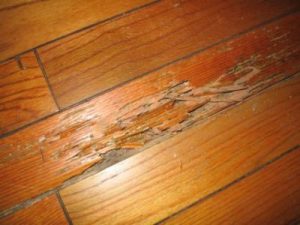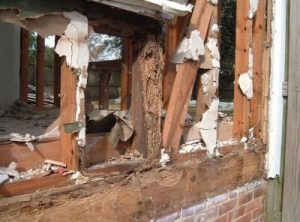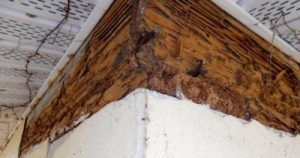
Termites have always been leading an extremely secret way of life thus representing a hidden danger for a man and his dwelling.
Just in a few years, a considerably numerous colony of subterranean termites can entirely destroy a house and, as a result, it becomes unlivable and ramshackle.
Termites are very difficult to identify: for years they can live and “work” in hard-to-get spaces of a house destroying it at ease.
Hide content
- Can Termites Live Under the Floors? What Damage They Can Bring?
- Photo
- Signs of Floor Decomposition Caused by Termites. Where to Find Clues?
- What are the Signs of Severe Damage?
- Useful articles
- Helpful video
- Conclusion
The best possible food for termites is wood, thou they are willing to gorge with cloths, cardboard and paper. It is easy to understand, that wooden houses or houses with wooden floors and ceilings will be in high-risk group.
Can Termites Live Under the Floors? What Damage They Can Bring?
The answer is: yes. If the house is infested, termites do live under the floors, especially if the floor covering have wooden ground joist and floor board also made of wood.Old houses that have their floors lying on bare ground (sometimes with sawdust or dry moss between ground and ground joists for warmth keeping) are in real danger, because such veiled places with the soil contacting with wooden structures are perfect for termites’ relocation.
When termites have such an easy transfer from ground to floor, soon they will occupy the entire house.
Just in few years, termites are able to destroy wooden floor, though, destruction can progress throughout an entire house: it doesn’t necessarily mean, that, if termites eat a floor, they do not eat another wooden structures of a house: their colonies are able to spread further and further.
The pieces of damage, that can possibly be done to wooden floors are the following:
- rotten and decomposed grounds joists;
- rotten pillars that connect soil with ground joists (namely, support them);
- decomposed floor boards, that can collapse any time.
As a result, wood floor damaged by termites can sink and break that is very dangerous for those, who live inside a house.
Also, when pillars and joists are faulty (in neglected cases) the entire house can begin to slowly sink: because the floor boards are rotten, the walls are also coming down curving, that will trouble the whole system of roof timber that can cause the possible partial or complete fall of roof.
There are cases, when it takes only load-bearing joist to become rotten to start the baneful process.But it is the most dramatic scenario in very uncared cases and can occur when the houses are already uninhabited for many years, but it describes the major principle of house decomposition beginning with the floor caused by termites.
Learn more about subterranean termites: signs of their activity; best methods of treatment and DIY methods. Eastern subterranean termites and their tunnels and tubes with photo.
Photo
See how does termite damage to hardwood floors look like on pictures below:
Signs of Floor Decomposition Caused by Termites. Where to Find Clues?
When you are making your regular inspection of house structures for termites’ activity, it will be a good idea to look under the floor if possible or if you have a basement that provides you an access to floor structures.
Advice: when conducting an inspection, use bright flashlight to peep into every single structure under your floor. Pay attention to corners, wooden joists and other veiled places, where termites can easily live and work for food and necessary moisture.Visible clues
The mold. Mold can only appear in damp und stuffy places, where the water collects or where there is faulty ventilation system. Termites also like such places.
It is possibly to say, that termites and mold in some cases represent a distinct connection. Mold is stinking and can be gray, yellow, green, white or black.
The mold is the sign that the wooden structure has already began to decompose and you should carefully inspect it for termites’ activity.
The mud tunnels. Termites construct mud tunnels to transfer throughout the house to search for necessary food and moisture.
Also, these tunnels serve as shelter and help them to maintain their vital functions.
Mud tubes can extend from the soil to the very floor on walls or be horizontal. They are of the pencil width and dark-brown.
Recommendation: you can check the mud tunnel for its activity. Destroy 2-5 cm of a tunnel with a knife or a screwdriver. The old tunnel will be dry and easily cracks. Check the destroyed area in a few days – if it is restored, it means, that you have a sound termite activity under your house and possibly above it. Even if the tube was not rebuilt, it doesn’t mean, that termites didn’t build a new tunnel somewhere near.Termites feces. It can be found either under the floor or on the floor, frequently in the corners or behind plinths.
It means, that termites live and destroy your floor, and their frass is the consequence of their living activity that is released during mud tunnels construction. Frass is like the sawdust but brown in color.
Be careful! Do not touch termites’ feces with your bare hands – it can cause allergy or contact dermatitis. Remove it with vacuum cleaner or brush. If you have already touch it, wash your hands with soap and water immediately. Conduct your inspections in protective latex gloves.Invisible clues
Hollow-like empty wood or wood with small holes in it. Sometimes, destroyed wood can sound empty and dull, though it looks normal.
You can easily check it with the help of a screwdriver: just softly nock the wood and hear the outcome. There are neglected cases, when after the screwdriver inspection, the decomposed wood starts to crumble and break.
It means, that the ground joist, for example, is completely rotten and needs to be replaced.
Such decomposition and fragility could be caused by mold or termites.
If there are termites, you will see holes in the food, or the wood will seem layered with brown frass.
Warning: of course, if you have found such a rotten joist or floor board, you can try to sand it to “living tissue” and cover with special chemical against termites. But pay a close attention, whether the joist is load-bearing or not: in most cases it should be replaced anyway because it is very difficult to stop decomposition (termites or mold spores have already gone further in deeper wood fibers).
Damaged floor will be shaky and unstable: floor board will curve after a single step and easily crumbling like chips; plinths will come off the walls, some floor areas will be with frass looking untidy.
It takes termites to destroy a floor from 2 to 5 years, but generally it depends on the age of a house, its type of the floor (on bare ground or with cement filling), moisture level under the floor and the condition of ventilation system.Also, some special anti-insect and anti-mold protective remedies are able to sufficiently slow down the process of decomposition.
Learn more about drywood termites: signs of their activity; best methods of treatment: spot treatment and DIY methods; how to get rid of them in furniture?
What are the Signs of Severe Damage?
The floor is badly damaged when its wooden joists are partially or completely decomposed by termites. Such wood will sound hollow and easily crumble, becoming very fragile.
Such structures should be replaced, because they can cause a damage to the integrity of the whole house.
When there are wooden plinths that also start to be eaten by termites, the process of decomposition can spread to adjoining row of beams (if the house is also wooden) that could be very dangerous to the whole house.
In neglected cases, the whole wooden structures of a floor become faulty and dangerous to tread upon. Such floor should be rebuilt.
Here you can learn more information about effective treatment method called tenting (fumigation): dangers for termites, preparing for fumigation and cleaning after, how long does this procedure last?
Useful articles
If you interested in more information of termites we recommend you to read the following articles:
- All types of termites. Are they harmful to humans? Can they bite you? And what is the difference between drywood and subterranean ones?
- What does swarmers of different species look like: drywood, subterranean, formosan?
- Signs of infestation outside and in the house: in walls or furniture.
- What does termite holes look like? What is droppings and is it toxic to humans? Do termites make noises?
- Posible termite damage, how does it look like? Examples of damage in walls.
- All about flying termites: how do they look like, swarming season and what to do if there are swarmers in your house?
- How do they do nests and mounds? How to find it in your garden or inside the house?
- Termite life cycle – from egg to larvae. And social hierarchy: workers, soldiers, queen.
Helpful video
Watch video and learn how termites can damage a bedroom floor:
https://www.youtube.com/watch?v=aBYgHG3ylww
Conclusion
Termites is a real hidden pest that is very difficult to detect at an early age.
Termites begin their “journey” to our dwellings where soil is connected with the house – namely, from the floor.
Only regular inspections of a house along with preventive measures (covering floor with special lacquer, soil treatment near the house) can protect you against severe damage that could be very costly and painstaking to eliminate.







